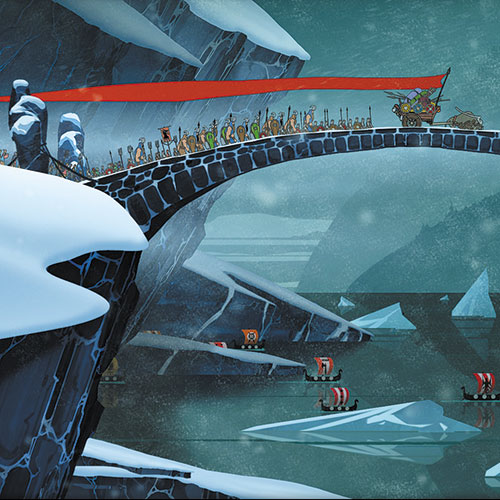Of massacres and mead

By Daniel Tack | Game Informer Magazine, MCT
“The Banner Saga”
Platform: PC
Style: 1-Player Strategy
Publisher: Stoic Games
Developer: Stoic Games
Stoic’s “The Banner Saga” is a turn-based tactical role-playing game rooted in choice and consequence. The Kickstarter title from ex-BioWare developers blends beautiful graphics and a haunting score by Austin Wintory. Players are thrust into an unforgiving Viking world and forced to make decisions that determine characters and gear availability, as well as group morale. As a grim tactical journey through frozen wastes and fields of foes, Banner Saga succeeds.
Combat is a tactical tightrope. Brute forcing encounters isn’t a viable option, and players may find themselves losing a battle or two even early in the game. With dozens of decisions to make during every encounter outside of positioning, tactics fiends will revel in the fact that simply eliminating an opponent may not always be the right choice. Due to the back-and-forth turn system that “Banner Saga” employs, foes may be more useful as a crippled turn-waster than a corpse on the field.
As characters level up via promotion, balancing raw stats and other options such as the expendable willpower resource becomes crucial. You manage quite a few resources in combat, from the basics like armor and strength to special abilities and armor break potential. Players call upon a large range of heroes, such as giant Varl that occupy multiple tiles, close range fighters, ranged archers and even special caster units.
The act of promoting characters carries with it some degree of risk, as the character could be lost forever during storyline development. Game-altering choices like this can be looked at a few different ways. On one hand, it certainly drives home the theme that choices matter and have serious repercussions. On the other hand, losing a character that you’ve invested considerable currency in can be a difficult pill to swallow. Currency used to level up characters is also used for purchasing items and supplies to keep the caravan healthy and full, further reinforcing the “decisions matter” theme running underneath the game.
Traveling through the wilderness from town to town represents a significant portion of the gameplay, full of stops that require input from the player to move on. These range from “Should we eat these suspicious berries we found?” to “We’re starving and out of supplies, should we threaten these poor farmers for their food?” Players also make more significant story choices that can add or remove characters from the party for good. Before you choose to send out Skafnard to examine those rustling bushes or invite a rather shady looking fighter to your entourage, make certain that your choices will protect the core team members that you’re developing.
Even if you are the type of player who doesn’t enjoy moving through dialogue menus, you should pay attention to these interactions or face potentially brutal consequences from a stray selection or misclick.
During caravan journeys, players also meet with enemies. Outside of the storyline battles, these encounters are an opportunity to pick up additional items and currency. While these battles are technically optional, skipping too many of them results in an underpowered team that may run into serious problems completing mandatory encounters, so the choice to retreat and lose some of the caravan’s retinue should never be taken lightly.
In addition to managing all of the above, characters that fall or take serious damage during an encounter become injured, requiring rest to function at full capacity. Days of rest cost supplies, so this adds yet another element that must be weighed carefully in order to succeed. A playthrough can be damaged to the point where the game must be restarted, though that danger is mitigated by the ability to change the difficulty setting.
If “Banner Saga” could use more of anything, it’s variety. The legions of Vikings and Dredge that players encounter have only a few different unit types and templates, and some variance would break up the tedious optional battles. Players gain access to a handful of interesting units and abilities over the course of the game, but the enemies feel like they could use some variation.
Depending on a number of factors, “The Banner Saga” should take around 6-20 hours to complete on first playthrough. Despite a few minor issues with enemy variety and the tedium of recurring encounters, “Banner Saga” stands out as an excellent tactical RPG with considerable depth.











